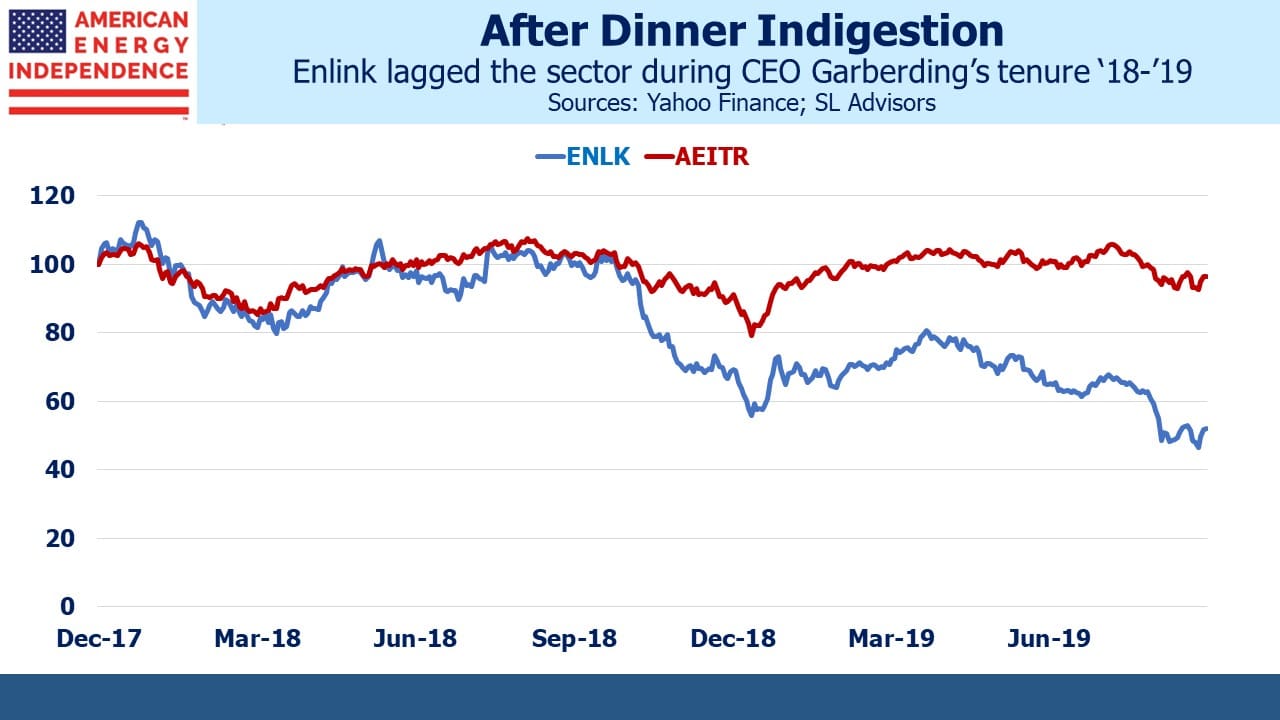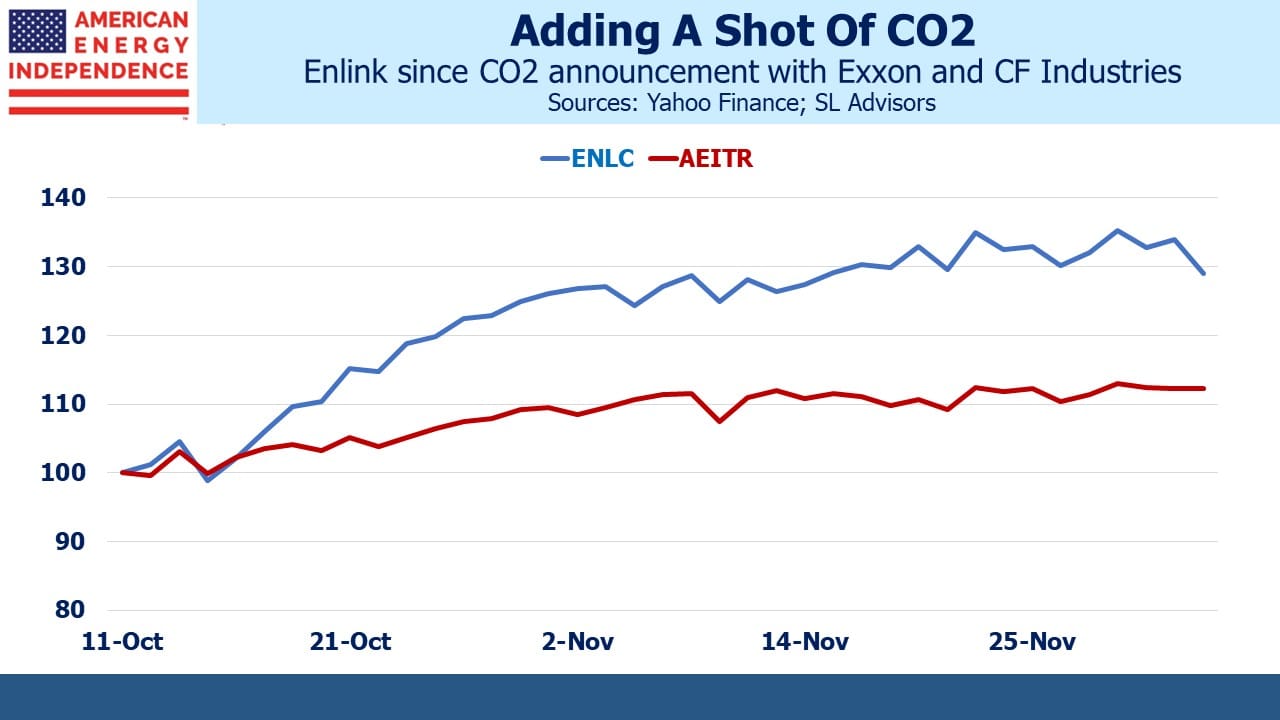Putting Carbon Back In The Ground

/
Dinner in late 2017 with Enlink’s soon to be CEO Mike Garberding and his management team was the most expensive I’ve ever had. Not because I had to pick up the check – they were gracious hosts. But because I left the restaurant impressed with Garberding’s grasp of the company’s opportunities and knowledge of the business. The result was we stayed invested in Enlink during Garberding’s time as CEO from January 2018 to August 2019, when it lost half its value.
Sometimes a careful, dispassionate analysis of a company’s SEC filings can tell you everything you need to know. Calls with management can improve your understanding but can also color your judgment. Eventually former CEO Barry Davis was pulled out of retirement to right the ship.
That was five years ago, and today Enlink is a different story. CEO Barry Davis retired (again) in the summer and was replaced by Jesse Arenivas who joined from Kinder Morgan where he ran their CO2 division. Enhanced Oil Recovery (EOR) used to be the energy sector’s main use for CO2, pumping it into mature oil wells to force out more crude oil. If the CO2 is permanently sequestered underground, it even earns a tax credit under Section 45Q of the tax code..
The recently passed Inflation Reduction Act (IRA) raised this credit to $60 per Metric Tonne (MT). Tax credits for producing crude oil may strike some as not consistent with reducing emissions, but the 45Q credits are turning out to be an important tool. The IRA raised the credit for CO2 captured from industrial processes to $85. Capturing CO2 from the ambient air (Direct Air Capture), where it’s 0.04% can earn up to $180 per MT.
Under its new CEO Enlink is positioning itself as a key player in carbon capture. Their 4,000 mile natural gas pipeline network in southern Louisiana supplies the majority of industrial emitters in the region. In October they announced an emissions reduction agreement with CF Industries and Exxon Mobil to capture 2 million MTs pa of CO2. CF Industries is a major producer of ammonia, the key input for which is natural gas. CO2 is a byproduct of this process. Enlink estimates the potential could be as much as 80 million MTs pa, over 1% of total US greenhouse gas emissions. CEO Arenivas said Enlink is aiming to be, “…the transporter of choice for carbon in Louisiana.”
Commodities typically flow from upstream companies (such as Exxon Mobil) via midstream (ie Enlink) to downstream customers like CF Industries. There’s an interesting symmetry in the agreement in that CF Industries will send the CO2 it generates through Enlink’s pipeline network back to the upstream companies who are best placed to understand which geological formations are suited for storage. The carbon is being returned to its point of origin. It left as CH4 (methane, or natural gas) and is returning as CO2.
Since the agreement was announced on October 12th, Enlink has outperformed the American Energy Independence Index (AEITR) where it was a 2.37% weight at the last rebalancing on September 30. Midstream energy infrastructure companies are developing an important role in reducing CO2 emissions. For years climate extremists have opposed new pipeline construction thereby driving up free cash flow. Remember to hug a climate protester and offer them a ride. They’re vital to putting the CO2 underground.
Last week Enbridge and Occidental announced plans to develop a CO2 pipeline and sequestration hub near Corpus Christi in Texas. Occidental will handle the CO2 storage and Enbridge the transportation, in another example of reversing the traditional direction in which the commodity flows. When it comes to carbon capture, upstream is the new downstream.
Carbon capture is a twofold benefit for pipeline companies. Reducing the CO2 released into the air by petrochemical facilities demonstrates that natural gas consumption is not living on borrowed time, and the subsequent carbon capture offers a new revenue source.
Meanwhile Europe is ramping up its capacity to import LNG. By 2024 they should be able to regassify 6.8 Billion Cubic Feet per Day, up by a third since 2021. Most of this additional capacity relies on floating storage and regassification units which can be operational more quickly than permanent, land-based facilities although they’re typically smaller as well. Poland is expanding capacity at an existing import terminal in the northwest. Within a couple of years there will be substantially more LNG tanker traffic through the North Sea and into the Baltic.
Until now Germany has never imported LNG, relying instead on natural gas from Russia via pipeline. Their energy policy is confused – long term goals to substantially reduce fossil fuel consumption remain in place, although they did recently sign a 15 year LNG deal with Qatar. They’re also contracting with trading house Trafigura to supply gas.
Enlink’s role in carbon capture is likely to be copied by other pipeline companies with similar infrastructure. This time we have no dinner plans with the management team.
We have three funds that seek to profit from this environment:

Important Disclosures
The information provided is for informational purposes only and investors should determine for themselves whether a particular service, security or product is suitable for their investment needs. The information contained herein is not complete, may not be current, is subject to change, and is subject to, and qualified in its entirety by, the more complete disclosures, risk factors and other terms that are contained in the disclosure, prospectus, and offering. Certain information herein has been obtained from third party sources and, although believed to be reliable, has not been independently verified and its accuracy or completeness cannot be guaranteed. No representation is made with respect to the accuracy, completeness or timeliness of this information. Nothing provided on this site constitutes tax advice. Individuals should seek the advice of their own tax advisor for specific information regarding tax consequences of investments. Investments in securities entail risk and are not suitable for all investors. This site is not a recommendation nor an offer to sell (or solicitation of an offer to buy) securities in the United States or in any other jurisdiction.
References to indexes and benchmarks are hypothetical illustrations of aggregate returns and do not reflect the performance of any actual investment. Investors cannot invest in an index and do not reflect the deduction of the advisor’s fees or other trading expenses. There can be no assurance that current investments will be profitable. Actual realized returns will depend on, among other factors, the value of assets and market conditions at the time of disposition, any related transaction costs, and the timing of the purchase. Indexes and benchmarks may not directly correlate or only partially relate to portfolios managed by SL Advisors as they have different underlying investments and may use different strategies or have different objectives than portfolios managed by SL Advisors (e.g. The Alerian index is a group MLP securities in the oil and gas industries. Portfolios may not include the same investments that are included in the Alerian Index. The S & P Index does not directly relate to investment strategies managed by SL Advisers.)
This site may contain forward-looking statements relating to the objectives, opportunities, and the future performance of the U.S. market generally. Forward-looking statements may be identified by the use of such words as; “believe,” “expect,” “anticipate,” “should,” “planned,” “estimated,” “potential” and other similar terms. Examples of forward-looking statements include, but are not limited to, estimates with respect to financial condition, results of operations, and success or lack of success of any particular investment strategy. All are subject to various factors, including, but not limited to general and local economic conditions, changing levels of competition within certain industries and markets, changes in interest rates, changes in legislation or regulation, and other economic, competitive, governmental, regulatory and technological factors affecting a portfolio’s operations that could cause actual results to differ materially from projected results. Such statements are forward-looking in nature and involves a number of known and unknown risks, uncertainties and other factors, and accordingly, actual results may differ materially from those reflected or contemplated in such forward-looking statements. Prospective investors are cautioned not to place undue reliance on any forward-looking statements or examples. None of SL Advisors LLC or any of its affiliates or principals nor any other individual or entity assumes any obligation to update any forward-looking statements as a result of new information, subsequent events or any other circumstances. All statements made herein speak only as of the date that they were made. r
Certain hyperlinks or referenced websites on the Site, if any, are for your convenience and forward you to third parties’ websites, which generally are recognized by their top level domain name. Any descriptions of, references to, or links to other products, publications or services does not constitute an endorsement, authorization, sponsorship by or affiliation with SL Advisors LLC with respect to any linked site or its sponsor, unless expressly stated by SL Advisors LLC. Any such information, products or sites have not necessarily been reviewed by SL Advisors LLC and are provided or maintained by third parties over whom SL Advisors LLC exercise no control. SL Advisors LLC expressly disclaim any responsibility for the content, the accuracy of the information, and/or quality of products or services provided by or advertised on these third-party sites.
All investment strategies have the potential for profit or loss. Different types of investments involve varying degrees of risk, and there can be no assurance that any specific investment will be suitable or profitable for a client’s investment portfolio.
Past performance of the American Energy Independence Index is not indicative of future returns.







Leave a Reply
Want to join the discussion?Feel free to contribute!